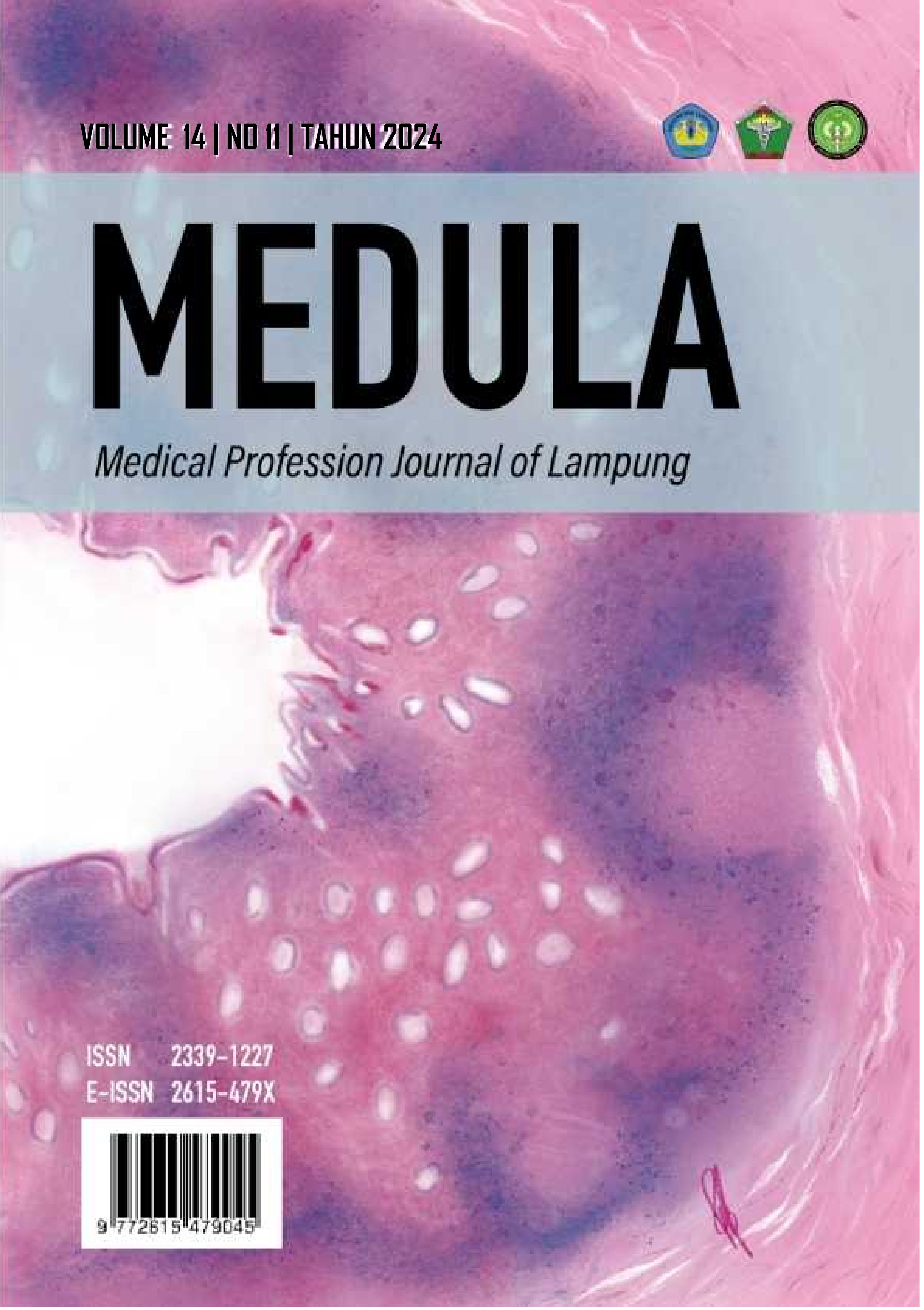Seborrheic Dermatitis: Etiology, Risk Factors, Pathophysiology, Diagnosis, and Management
DOI:
https://doi.org/10.53089/medula.v14i11.1327Keywords:
Inflamations, seborrheic dermatitisAbstract
Seborrheic dermatitis is a type of chronic skin inflammation caused by the fungus Malassezia sp. which is often found among patients. The prevalence reaches 4.38% on a global scale and 2% - 30% in Asia. Often found in infantile (self-limited) and adult (chronic) patients. This disease is considered to reduce the patient's quality of life. The high number of cases and the rate of decline in patient quality of life due to seborrheic dermatitis became the basis for conducting this research. Research was conducted to collect and analyze articles that raise topics related to clinical aspects of seborrheic dermatitis. The research design used was a literature review. Article collection was carried out using relevant article search applications such as Google Scholar, PubMed, and Prospero. The articles used have a range of publication criteria in 2013-2024. Based on the articles collected, results were obtained in the form of risk factors, pathophysiology, diagnosis and management of seborrheic dermatitis. Risk factors that are considered to trigger seborrheic dermatitis include high sebaceous gland activity, low body immunity, physical environmental factors in the form of humidity and temperature, and a history of poor personal hygiene. The appearance of the disease is in the form of reddish lesions covering fine colored scales, sometimes accompanied by oil or white powder. The severity of the disease is determined through the SDASI score or Seborrhoeic Dermatitis Area Severity Index. Healing therapy aims to reduce symptoms and improve skin function. The type of therapy given is based on the lesion severity index and the patient's response to therapy.
References
Karimkhani, C. et al. Global Skin Disease Morbidity and Mortality an Update From the Global Burden of Disease Study 2013. JAMA Dermatol. 2017; 153(5): 406–412.
Araya M, Khultanan K & Jiamton S. Clinical Characteristics and Quality of Life of Seborrheic Dermatitis Patients in a Tropical Country. Indian J Dermatol. 2019; 60(5): 519.
Ozcan, Y., Sunggur, M., Ozcan, B., Eyup, Y. & Ozlu, E. The Psychosocial Impact of Chronic Facial Dermatoses in Adults. Dermatological & Practical Conceptual. 2023; 13(1).
Kang, S. et al. Fitzpatrick’s Dermatology in General Medicine 9th Edition. United States : McGraw-Hill Education. 2019.
Argirov, A. & Bakardzhiev, I. New Insights into the Etiopathogenesis of Seborrheic Dermatitis. Clin Res Dermatol Open Access. 2017; 4(6) : 1–5.
Griffiths, C., Barker, J., Bleiker, T., Chalmers, R. & Creamer, D. Root’s Textbook of Dermatology. United Kingdom : John Wiley & Sons. 2016.
Polaskey, M., Chang, C. & Daftary, K. The Global Prevalence of Seborrheic Dermatitis A Systematic Review and Meta-Analysis. JAMA Dermatol. 2024; 160(8) : 845–855.
Marganingsih, D. Dermatitis Seboroik di RSUD Panembahan Senopati Bantul Tanun 2020. Yogyakarta : SMF Kulit dan Kelamin RSUD Panembahan Senopati Bantul. 2020.
Akbulut, T., Suslu, H. & Atci, T. Is the Frequency of Seborrheic Dermatitis Related to Climate Parameters. The Medical Bulletin of Sisli Etfal Hospital. 2022; 56(1).
Munthe, P. Hubungan Lama Penggunaan Helm dan Personal Hygiene dengan Kejadian Dermatitis Seboroik pada Ojek Online. Palembang : Universitas Muhammadiyah Palembang. 2022.
Sanders, M., Pardo, L., Ginger, M., Nijsten, T. & Jong, K. Association Between Diet and Seborrheic Dermatitis: A Cross-Sectional Study. Journal of Investigative Dermatology. 2019; 139(1): 108–114.
Adalsteisson, J., Kaushik, S., Muzumdar, S., Yassky, E. & Ungar, J. An Update on the Microbiology, Immunology, and Genetics of Sebhorreic Dermatitis. Experimental Dermatology Wiley. 2020; 29:481–481.
Alawiyah, E. Perbandingan Tingkat Kesembuhan Luka Bakar Derajat II Antara yang Diberi Madu Topikal Nektar Kopi dengan Moist Exposed Burn Ointment (Mebo) pada Tikus Putih (Rattus Norvegicus) Dewasa Jantan Galur Sprague Dawley. Bandar Lampung : Universitas Lampung. 2013.
Gayatri, L. & Barakbah, J. Dermatitis Seboroik pada HIV/AIDS. Berkala Ilmu Kesehatan & Kulit Kelamin. 2011; 23(3).
Hajjar, S. Manifestasi Klinis Dermatitis Seboroik pada Anak. Jurnal Kedokteran Syiah Kuala. 2015; 15(3).
Bholah, N. & Gomez, J. Seborrhoeic Dermatitis. 2022. https://dermnetnz.org/topics/seborrhoeic-dermatitis
Kemenkes RI. Pedoman Nasional Pelayanan Kedokteran Tata Laksana Dermatitis Seboroik. Jakarta : Menteri Kesehatan Republik Indonesia. 2019.
Downloads
Published
How to Cite
Issue
Section
License
Copyright (c) 2025 Medical Profession Journal of Lampung

This work is licensed under a Creative Commons Attribution-ShareAlike 4.0 International License.














